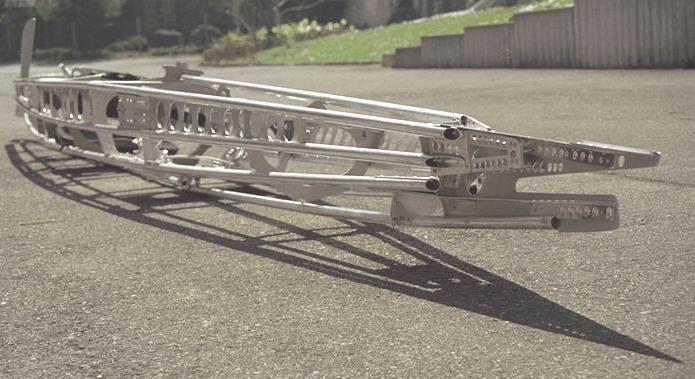






Construction Details.
You should try to avoid round tubular aluminum stock; although George Dyson is
very fond of that, it does not make much sense for a foldable construction
(Here is a better solution).
This is because in a foldable boat, there are few occasions to lash tubular
components and seal the lashings with epoxy. Instead, I am using aluminum
rivets that can be drilled out again and change the most important rivets
to stainless steel type or to a larger diameter when I am done with the
boat.
Riveting tubular material is difficult; at the time I was using the stock I have bought four years ago and when I am done with that, I will buy rectangular material with rounded edges. Stuff like this definitely exists, and I have some of it. The optimal material, from my point of view, seems to be the high-tension 25mm x15mm rectangular tube with a wall thickness of 2mm. It is a little small though, but I hope it can easily be riveted and so joined with aluminum plates. If not, I'll try the larger versions. Those joints are necessary at any locations where the pieces of the boat need to be easily separatable.
The new design has only four stainless steel screws at places, where everything else seemed inconvenient enough for me to admit additional tools for assembling the boat. Usually, I do not take the boat apart; the only (and important) time that I did this was on the trips to Canada and Norway. And then, I had the time to fix all those screws. Here in Germany, for example, I do not take bow and stern apart; I have the space to store and carry them assembled, because the Lake of Constance is just a short walk away.
The design makes limited use of those stainless steel pins, that you can buy at sailor's shops and that need a round, springy splint to prevent them from falling out of their hole. At convenient locations, the two stringers and the keelson are simply riveted together. This creates some large parts, larger as the gunwale parts. But size was no problem on our trip; more important was weight, and that stays the same. The idea of this is to create a few, large but rigid components that can easily be disassembled and that have no weak joints at locations of maximum stress.
I did all the cutting of the aluminum plates with a band saw, and that really is noisy. Expect your neighbors to make trouble if you cannot access some factory or remote workshop. The next big task was glueing the PVC skin. My brother sewed the deck parts of cotton; this reduces the amount of toxic fumes in the workshop.
Apropos workshop: mine was at times my garage, and that's why I am fond of these sawhorses as a building bed. I push the car out of the garage, take the boat off the wall and put it onto those sawhorses. Later in the evening, the garage may resume its function within minutes. To prevent sharp aluminum parts or the pins of the pop rivets puncturing the tires, and to protect new PVC skins from getting oily, I have laid an old carpet on the garage floor which I remove after usage.
Another detail are the strips of used bicycle tire that I have sewed onto strips of PVC and then glued onto the keelson at the bow and stern. The idea is to reduce abrasion of the skin. This does a good job especially when I carry the boat on wheels.
Contributors to this page: Thomas Yost (TDY), Patrick Poirier (PPR), Gerald Maroske (GUM) and Hendrik Maroske (HHM)